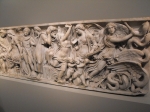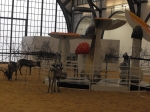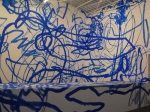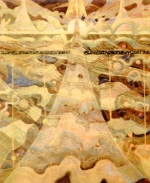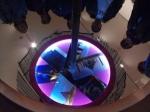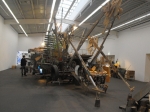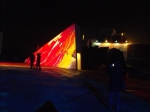Author: Vera Vorobjova
Among the eternal questions, whose reflection inspire and spiritually enrich mankind, the question of sense and mission in art is one of the brightest and most difficult.
Throughout the existence of culture, every epoch and every society has allocated art by unique missions.
The strict and rational system of artistic expression of ancient Egyptian art conveyed the sacral meaning of the ritual connected to the transition of the soul with the timeless world. Canons corresponding to ancient Egyptian art have been urged to provide a realization of the raised mission of the connection of the soul with eternity. The art of ancient Greece inspired harmony and aspiration to an ideal and its canons corresponded to the given mission. Products of cult art during the Middle Ages have been urged to direct the soul of the person to the Divine; becoming symbols of the inexpressible sacred sense of life. The given mission of art dictated the canons of creation as well as the perceptions of the given art. Renaissance art connected the terrestrial and the heavenly in the beauty of human life. The Baroque style reflected the resistance and interweaving of light and darkness and the diversity of life; creating unique forms and canons.
We can see that the art of every epoch, culture, and new style is a reflection of the main driving idea; a spiritual orientation of the given epoch or culture. However, with the beginning of the great and tragic twentieth century, it becomes harder and harder to talk about a certain common orientation between our civilization and the culture of the people.
The inabilities of any morals or ideology to prevent wars, ecological disasters, and deep dissonances in a human civilization have led to the disappointment and mistrust of morals and ideologies. Spiritual crises, the formation of a consumer society and the protest against it, evidence of senselessness as a way of destruction, and searches for new spiritual integrity have caused the formation of new art.
This art has allowed itself no canons and ideals. It has allowed itself to become an arbitrary art. It is not always able and willing to be a source of beauty and spirituality and it is not always clear and open for understanding.
What does contemporary art hide within itself? Does it assume the presence of sense? What are the limitations and potential of contemporary art? What is its mission in the present culture if this mission exists?
These questions are considered by the given research.
By the term “contemporary art” — which is in many respects similar, but not identical in meaning to the term “modern art” — we mean the totality of contemporary, artistic practices that are based on a creative experiment associated with the subjective reflection of reality. This experiment is inherent in the exploration and generation of new ideas, concepts, images, new tools, and materials of expression; up to the dematerialization of the object (happenings, performances).
The comprehension of contemporary art requires us to work with the following groups of questions:
- What are the preconditions associated with the birth and development of the contemporary art that keep its search away from the sphere of the fine?
- What caused the birth of inharmonious art?
- Does it have a meaning and a creative potential?
- What is the contemporary art author’s purpose if it exists?
- What does the contemporary art await from the audience?
- Under what conditions are constructive effects possible in the interaction between the object and the viewer of contemporary art?
So, what are the preconditions associated with the birth and development of the contemporary art that keep its search away from the sphere of the fine? What caused the birth of inharmonious art? Does it have a meaning and a creative potential?
“Our soul which only has recently cleared up from the long period of materialism conceals in itself a despair germ — a consequence of disbelief, senselessness and aimlessness. Yet absolutely passed the nightmare of the materialistic views which have made of life of the Universe malicious aimless game…the clearing up soul still lives under strong impression of this nightmare…”
V. Kandinsky, About Spiritual in Art
All art reflects the era in which it was born and anticipates the development of culture, enriching it with new values and ideals as well as company warnings of possible errors of development. The last of these functions has a particularly deep connection with the sphere of contemporary art. The art of a contradictory era should have inconsistent, contradictory directions. Such a direction is contemporary art. The emergence and development of contemporary art is a natural process.
As a reflection of the disease and isolation (and sometimes the absurdity of the modern world and understanding ways of healing), it affects the search for new values and new cultural and spiritual support of the person. This creative process, which includes a great variety of disparate phenomena, is capable of both enriching and ennobling art and destroying its basis connected to the spiritual maintenance of an image. We will try to understand why.
What is the possible meaning and creative potential of contemporary art?
Modern society, with its huge potential for development, is largely characterized by a loss of immutable standards of goodness, truth, and beauty. The set of values and ideals of the past, born of different ideologies, has been limited, destructive, unsustainable, or unrealistic. Values that are able, not to divide, but to unite and really elevate humanity, are in the process of formation and interpretation, requiring the interpretation of the past and present at a higher level of understanding without division into absolute good and evil; without total failure, praise, and vilification of different ways of development. The depth of environmental, political, and spiritual discord within contemporary society leads to the urgent need for a new conception of human existence in the world; which implies a search for the meaning and wisdom of the grain in each experiment of the past, as well as creating a new unity of diverse ideas and cultures.
Contemporary art as an art of free creative search proclaims a refusal of claims on the validity of those or other doctrines, ways, and ideas. This refusal, along with the aversion of formalism in culture and life, at a level of creative ideas of equivalent plurality.
The birth of modern art due to the disappointment of the omnipotence of reason is also due to the appeal of the world of sense, subjectivity, and the personal. The appeal to the world of sense; the subconscious mind and the viewer at the level of abstract forms, concepts, images, and creative action of the artist, purified from secondary content and a clear story, is fraught with new, not yet investigated possibilities of a spiritual impact on the viewer.
The birth of contemporary art in its most penetrating form can be regarded as a resuscitation of the human soul dying from the absence of strong feelings and impressions of indifference in our pragmatic epoch.
Contemporary art, in some of its manifestations, is painfully frank in its diagnoses of the disease of society.
The art of game and the interpretation of contemporary art become a revolt against the imaginary spread by mass culture (the one-dimensionality of the multidimensional person) and against a deep, heavy dream which takes the lives of a thousand people. Such art bears in itself a negation to the transformation of a person into the insensible device; an interchangeable small screw of a huge public system. Contemporary art in its best displays allows the realization of the absurdity of the preset existence originating from the realized choice, out of the freedom and responsibility of the person for boundless possibilities of life. This realization leads to the fact that a person cannot mechanically reproduce a limited set of reactions and does not suffer.
The most powerful art gives a person the chance to start to suffer without the real life; with the unique sense, beauty, and dream that can be turned into reality.
The creative potential in the area of contemporary art is also connected with the search of new expressiveness that an abstract image possesses. In this creative search, the artist makes a movement from a display in the form of objects to the reflection of their multidimensional internal maintenance, idea, sense, vibration, and unique atmosphere, which is created by things. Just as many centuries before the icon painter departed from the detailed transfer of anatomy and proportions of a human body for the sake of capturing the spirit that dwells in this body, so a talented contemporary artist who creates abstract images tends to reflect on and display the hidden secret essence of things.
The given area of creative search is capable of enriching the art of the present through new depth, force, and rare spiritual fullness.
However, contemporary art also has inconsistent, at times destructive, lines. Freedom in the name of creative exploration and the ultimate revelation of the author often turns into a barren freedom of spiritual values and the meaning of the created.
The empty forms filled with nothing or filled with destructive emotions not rethought by the author or melted into wisdom, are capable of entering into a resonance with the darkest and most destructive in the soul of a spectator, giving rise to painful imaginations and destructive ideas. The spectator doesn’t rise above the aspiration of the author. If the author isn’t directed to any of the eternal ideas, his art can harm. The great and unsafe force of influence of art was known to all civilizations and cultures of the past. The freedom of the artist has always been limited by his internal need to service the idea conduction the person and culture to wisdom and sensibleness. The occurrence of a resonance with art whose ideas have no creative potential is pernicious for a human civilization.
What is the contemporary art author’s purpose if it exists?
“Mission of the artist — to send light to depths of the human heart,” so Robert Schuman understood the role of the author to be. Thousands of years of cultural existence were conformable to these words. “The artist is a person who can draw and write about everything…” Lev Tolstoy has noticed. It is the understanding of the freedom of the artist’s choice which is in accordance with the views of contemporary artists.
The author does not promise to enlighten and uplift the viewer; he does not explain, does not edify us, or complete his creation.
A role of the author of contemporary art — creation of realities through which it is possible to travel, finding in different images an own sense and new unity. The author of modern art creates an open system that is ready for interpretation. Important things are the expression of the private world of the artist, his state of mind, and his own reaction to the surrounding validity. Such frankness of the author becomes more important and valuable than a plot or idea of an art object. The author himself does not hide the state of mind and feelings behind a picture plot; not allowing the mind of the viewer to get lost in the analysis of the plot, moving away from response and feelings of empathy.
Thus, in view of the multidimensionality of contemporary art, it is capable to lead the mind of the spectator to intuitive thinking and lead the soul of the spectator to direct feeling.
The space of contemporary art is poetically named “The Garden of Escaping Senses,” or “The Garden of Elusive Meanings.”
The author lays down a challenge to the spectator: “What can the spectator create in his consciousness from this mysterious chaos?” This chaos is so similar to the chaos of the life from which the person takes or doesn’t take a precious unity of sense.
The chaos is perceived by the author of contemporary art as a source of updates and new possibilities.
During the creation and perception of contemporary art, there is a deletion of borders between art and life. Sets of subjects of daily occurrence get the role of bright metaphors in the creation of collages, performances, and happenings. The thirst for deep interaction between reality and art, and between the spectator and the art-object is caused by the requirement for a new perception of the human life as an act of creativity. The effect of creating sensual experiences through contact with objective reality substitutes for the fine art of the past that is isolated from the reality of the picture frame. In the same way, it substitutes for the virtual reality of the Internet and worlds created by the film industry, with all their depth and intensity at times misleading people on all events and the choices in their own life; the reality of “here and now.”
Thus, the creation of unity between objective reality and the world of art in objects of contemporary art, such as happening and performances, are the response to the dominance of the ghosts of things that replace the human experience.
It is necessary to note two more qualities introduced by the author of contemporary art in his creations: irony and citationality.
Irony - Absence of the claim of possession is a unique and true sense; a key to a solution of secrets and a rescue source introduce a shade of irony and self-irony from the author in many products of contemporary art. Behind this irony can appear both bitterness from a loss of sense and disappointment, and a belief in the inexpressible happiness of the human existence.
Citationality - While creating an art-object, the contemporary artist enters a dialogue between a set epoch and styles, persons, and ideas. As a result of such a dialogue, the art object can contain the echoes of images and ideas of other products. The depth and brightness of this dialogue depends on the intellectual riches and the inner world of the author. While traveling on the space of senses created by the author and forms, the spectator becomes involved in a deep conversation between the artist and the art world, whose sense is opened to the viewer as much as the diversity of his own intellectual and spiritual experience.
It is necessary to notice that sometimes a claim can be a multi-dimensional, hidden rip-off or a simple lack of original ideas of the author’s part. The more a thin sphere becomes opened for display by art, the less possibility there is to clearly distinguish original false depth and uniqueness in a work of art at the intellectual level. Only the intuition and the presence or absence of a sincere response to a product can oversee the preferences of the spectator of contemporary art clearly enough.
What does the contemporary art await from the spectator? Under what conditions are constructive effects possible in the interaction between the object and the viewer of contemporary art?
As was noted earlier, contemporary art contains a protest against the suppression of the creative human nature that has wallowed in the elements of stereotypic, standard thinking. Therefore, contemporary art creates the problematic situation containing the keys to the understanding of an art product, but not its ready, unequivocal treatment.
Thus, the art object grabs the man from the sphere of stereotyped forms in the usual zone of comfort and moves him to the search of sense.
Overcoming the unilateral assessment view of art and reality, the viewer (if he wishes) seeks to comprehend the polyphonic work and gives his own meaning arising from the association and thought of the art object.
Thus, the meaning of work is the fruit of the co-creation between the author and viewer. Without the active position of the viewer, a piece of modern art is often a heterogeneous chaos of ideas and forms.
he interaction of many points of view presented in the polyphonic art object gives the viewer no impetus to find meaning in art and life; but to learn to endow art and life followed by a unique sense, to choose the most consonance with his “ringing” in the submitted polyphony, to make his own idea, to choose a new position in the perception of art and also in his own life.
Thus, the creative potential of contemporary art can enrich the viewer with the possibility of true co-creation with the author; thinking about life and searching for points of view, where one can enjoy a deeper understanding of the phenomena of reality as well as his own spiritual essence.
So, we have identified the rich opportunities of contemporary art to communicate with whom the creative activity of the viewer is important, as well as his willingness to go beyond the usual, presenting the surrounding area and form with his own interpretation and sense.
Let us notice that rich possibilities of contemporary art are not always realized in products, and that it should still be proven in full capacity in future art if the orientation of contemporary art conforms to the creative potential of human culture.
Such interdependency between an orientation of art and its potential is comprehended by the extraordinary bright thinker and painter, Vasilij Kandinsky:
“…Yes, art is the child of time. But such art is capable to repeat only in artistic form what already clearly fills the modern atmosphere. The art which is not concealing in possibilities for the future, art which is child of its time only and which never becomes the mother of the future, is art emasculated. It is short-term; it morally dies while the atmosphere which has created it changes. The art capable to the further development also has roots in the spiritual epoch, but it is not only an echo and a mirror of last, it possesses a great visionary flickering power, capable to operate deeply and on the big extent.
Spiritual life, part of which is art and it is one of the most powerful parts, spiritual life is a movement forward and upward.”
Learning thoughtfulness and tolerance from life, as well as in contemporary art, the author of this research shares the idea that all creative art directions at their core are able to make sense, play a special role in the development of culture, and have a unique potential. Without replacing or forcing out the wonderful world of classical art, but exploring new opportunities for creative search; contemporary art can lead the artist and the viewer to a new openness, frankness, and a new depth of interaction and co-creation.

